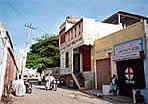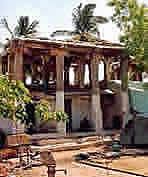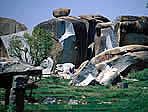| Conservation |
| The Bellary and Koppal Districts, in which the site of Vijayanagara is situated, are undergoing rapid development. The Tungabhadra Dam, completed in the early years of Indian Independence, did much to facilitate local agriculture, mining, steel manufacture, and smaller industries in the area, the growth of which has continued to the present day. Recent improvements in transport and increased wealth have resulted in an unprecedented acceleration in pilgrimage and tourism. Such developments have had an adverse impact on the site, which now faces grave risks. Changes have been most dramatic in the village of Hampi, which had in recent decades been transformed into a bustling pilgrim centre, with unauthorised concrete buildings encroaching, and in some cases supplanting ancient structures. The authorities have deemed these structures unsuitable and illegal, and from July 2011 onwards ordered the bulldozing of houses, shops, restaurants and hotels. The bazaar street in front of the Virupaksha temple is now devoid of life, flanked by exposed, empty colonnades. It is by no means clear how the authorities mean to relocate the people displaced in this ruthless manner, or even if and when they will permit renewed facilities for pilgrims and tourists. Elsewhere at Hampi, inappropriate whitewashed masonry ashrams and religious institutions have grown up in archaeological areas, and farmers and building contractors have been busily demolishing ancient walls to make way for roads, wells and water channels. A vast concrete ghat has obliterated Vijayanagara period riverside features in Hampi. Even the magnificent landscape of the site has suffered: boulders and sheetrock are quarried or painted with signs; the river is disfigured with inauthentic and unsightly concrete steps; and a new highway bridge across the Tungabhadra leading to Anegondi was begun, which threatened to bring heavy road traffic through the middle of the site. However, the bridge collapsed in January 2010, tragically killing several people; its unsightly debris in the river has yet to be removed. Hampi village and other settlements in the region have long held periodic religious festivals that often attract many local people. From the late 1980’s the state government has sponsored an annual Hampi Festival. These have attracted large crowds and have required the development of large, expensive and unsightly facilities in the Heritage Zone of the site. Among the varied events, lavish stage productions are preceded by political rallies. It is said that a huge fireworks display at a recent festival caused one of the Sister Stones, popular with climbers, to collapse. Recent archaeological work by central and state authorities has focused on repair or rebuilding of monuments and exposure of buried structures, rather than on scientific research on the history of the site. While it is true that the archaeological authorities actively protect the most outstanding historical monuments of Vijayanagara, rebuilding has normally proceeded without documentation and reporting of the original building fabric. Archaeologists have also been active in clearing parts of the Sacred and Royal Centres, thereby exposing significant remains of temples, palace complexes and other courtly structures. Once revealed, too frequently they have been unreported and left to decay. And, while these areas are rich with buried cultural remains, artefacts associated with these structures, or found in the areas between the monuments, have not been documented, analysed, curated or published. There was some hope to improve the restoration standards with the recent collaboration between the Global Heritage Fund and the Jindal Foundation. This focused on rehabilitating the Chandramauleshvara temple overlooking the Tungabhadra. While the masonry faces of the terraces on which the temple stands have been imaginatively reconstructed, no archaeological documentation has resulted; conservation work on the temple has yet to be completed. A Master Plan for the site has now been prepared by the Hampi Authority set up by the Government of Karnataka, and an Integrated Management Plan has been commissioned by the Archaeological Survey of India. However, neither of these plans has been systematically implemented. The result can be seen in the ruthless destruction of Hampi village, already noticed; the unnecessary and careless reconstructions of historical monuments; and the lack of concern to safeguard the site’s unique natural setting. UNESCO, on whose World Heritage List Vijayanagara was inscribed in 1986, can do little more than offer advice. How these shortcomings are to be overcome is by no means clear. Sadly, there is little reason for optimism given the lack of clear direction of how the site is to be managed in the future. For a discussion of the issues surrounding Hampi’s destruction see Fritz and Michell 2012 ''Letter from Hampi'' in Project Publications or link to the article's web page. http://www.archaeology.org/issues/53-1211/letter-from |
|
|||||||||
| Top |




